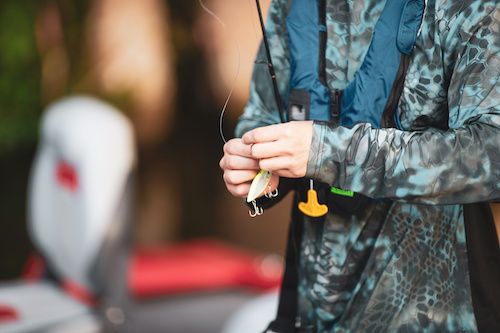
How to Kickflip – Kickflip Trick Tips
How to Kickflip – Kickflip Trick Tips Mastering the kickflip is a pivotal moment for any skateboarder, marking a transition from beginner to
You may have recently discovered just how much fun freshwater fishing can be, or maybe some recent saltwater fishing excitement has got you hooked on the sport, but no matter how and where you fish there are some basic fishing tips for beginners that all anglers need to know.
Are you ready to catch more fish while you’re casting, enjoy trolling triumph, and have a blast while bottom fishing? Of course you are—and keeping these 10 top tips in mind will help make it happen.
Here are 10 Beginner Tips for Fishing:
1. Matching Lure Colors to Water Conditions
Align your lure color with the water’s hue. Fish can be particular about lure color preferences, so it’s wise to experiment when bites are slow. However, as a basic guideline, opt for lures that blend with the water’s color.
– For green water, consider lime or chartreuse hues.
– In clear water, opt for white or pearl shades.
– In tannic-stained water, go for root-beer tones for better results.
2. Fishing Lure Shapes & Sizes
Choose lure shapes and sizes that let you “match the hatch.” When predators are feeding on a school of small, thin fish like anchovies, a small, thin spoon that’s the same shape and size as those baitfish will often prove deadly — but a five-inch lure with a wide body may well go untouched.
Profile and length are usually the key features in this regard, because your quarry may well be focused on the shape and size of the prevailing bait and ignore other offerings.
3. The Right Size Fishing Gear
Get fishing gear that’s sized appropriately to the fish you’re pursuing, and don’t try to get one-size-fits-all rods and reels. The 12-pound-class casting reel you love using for bass is simply too heavy for tossing the tiny jigs and spinners that black crappie like to hit, and the four-pound-class ultralight that’s ideal for casting micro-jigs to those crappie can’t handle a big largemouth bass. Middle-of-the-road gear won’t be ideal for either task. Rather than trying to make do, get gear that’s sized for the species you’re targeting.
4. Mastering Trolling Techniques
When trolling (moving slowly while trailing lures behind the boat), take a moment before releasing the lines to observe the lures closely next to the boat. Ensure they swim naturally; if they appear sluggish, increase your speed slightly.
Conversely, if they seem erratic, reduce the throttle. This allows you to find the optimal boat speed and ensures your lures are in good condition and swimming properly before setting them out.
5. Selecting Fishing Line
With numerous types and brands available, choose your fishing line wisely. Explore resources like “Saltwater Fishing Lines” and “Freshwater Fishing Tackle” to understand the various options.
As a rule of thumb, braid lines offer high sensitivity and excellent hook-setting power, making them ideal for lure fishing. Conversely, monofilament line, with less sensitivity and a bit of stretch, is better suited for bait fishing when fish are nibbling.
6. Prime Fishing Hours
Make the most of the early and late hours of the day for fishing. Dawn and dusk are prime times for many fish species, as they tend to bite more actively during ambient sunlight. During mid-day, fishing can improve with cloud cover, while in direct sunlight, especially in summer heat, seek shaded areas. Just like us, fish often seek shade in hot, sunny conditions and become more active during cooler periods of the day.
7. Tides & Currents
When fishing in saltwater, consider the tides and currents alongside the time of day. These natural movements greatly influence how, when, and where saltwater fish feed. Explore “The Secrets of Tide Fishing” for deeper insights into this aspect.
8. Sharp Hooks
Ensure your hooks are sharp by either using new ones or sharpening the old ones. While it may seem like common sense, many anglers overlook this step. While dull hooks may catch a few fish, sharp hooks significantly increase your chances of success.
9. Reel Drag
Properly set your reel’s drag using a scale. This feature allows fish to take line without breaking it, and its adjustment is crucial. While some may rely on guesswork, it’s best to use a hand scale and set the drag to one-third of the line’s rated breaking strength for optimal performance.
10. Research
Before heading out, conduct thorough pre-fishing research. Each fishing method and species has its own nuances and specific tips. Explore various fishing tips articles to enhance your knowledge and skills.

How to Kickflip – Kickflip Trick Tips Mastering the kickflip is a pivotal moment for any skateboarder, marking a transition from beginner to

How to Put on Knee Pads for Work When working outdoors or participating in sports, protecting your knees is essential. Quality knee pads not

UNDERSTANDING FISH HOOK SIZES Mastering the art of reading fishing hook sizes is a simple yet crucial skill. It boils down to one key factor:

PICKING THE PERFECT FISHING REEL Understanding the various types of fishing reels is easier than you might think. While there’s a wide array of options